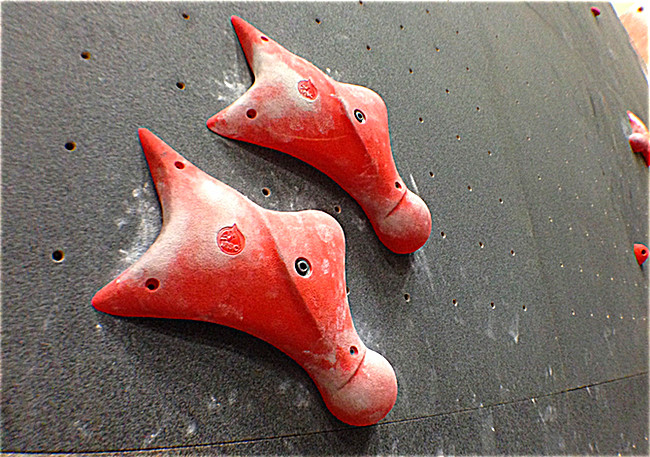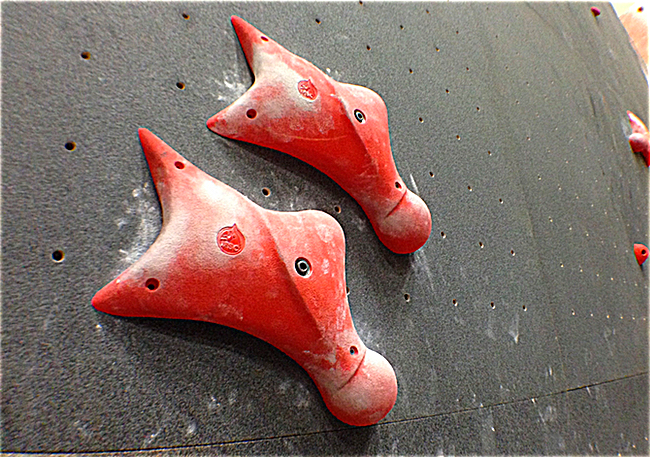
by Joe Robinson
You train for years. You chalk up, climb and repeat for months. You make the slightest changes to save milliseconds. You get stronger. You get faster. You register and pay. You get vaccinations, book flights. You arrive in another time zone. You step in front of hundreds of eyes and a spotlight. You clip in. You hear the beep. You climb. You lose. And you wonder what you were training on, because it was not these holds.
If you are a speed athlete, coach or gym owner frustrated by similar changes, you are not alone in this sentiment. “They are definitely different,” says Pat Enright, owner of MetroRock Climbing Centers. “There are some juggy parts on these holds, and the juggy parts are definitely juggier.” Other people have noticed a change in the holds used at speed climbing events. “All the speed climbers are like, ‘You don’t have the right holds,’” continues Enright. “What you had has become obsolete.”
So just what happened to the Speed holds?
Certification
According to Jerome Meyer, sport manager of the International Federation of Sport Climbing (IFSC), the IFSC partners with and certifies climbing holds manufacturers to provide official speed climbing holds for use at sanctioned events and for training. Hold manufacturing companies wanting to become official producers must submit an application to the IFSC which addresses two concerns: 1) the duplicability of speed holds; and 2) the logistics of operating a global program. Experts in the IFSC Sport Department then conduct a technical evaluation and the IFSC Executive Board reviews their report before making a final decision.
The importance of operational logistics is self-explanatory: the holds are used at competitions around the world and the manufacturer needs sound internal resources to ensure the holds get to where they are needed.
The importance of duplicability, on the other hand, requires a bit more explanation. Different from Lead and Bouldering competitions, Speed climbing events are not based on the difficulty of different climbs, but instead the time it takes to complete a standard route. Consequently, for any comparisons in time to be significant, the exact same wall and route configuration must be used at every event. To accomplish this the IFSC established a standard by which athletes competing anywhere in the world can compare themselves for a Speed World Record. The 2015 IFSC Rules Handbook sets the following criteria:
A World Record in Speed can be set only:
- On a Climbing Structure certificated by the IFSC to meet the requirements for a World Record;
- Where the timing system in use has been certificated by the IFSC to meet the requirements for a World Record;
- Where the competition is included in the official IFSC calendar of events; and
- Where a Jury President has been appointed by the IFSC. The Jury President shall report any new World Record to the IFSC.
For a speed wall to become certified, an IFSC Technical Delegate must approve that it conforms to IFSC Speed License Rules which dictate the exact height, width, inclination, rope protection, t-nut grid, granulometry and color of the wall. The rules also govern aspects of the holds, including shape, color and thickness.
The duplicability of speed climbing holds, then, is merely one piece of an ongoing IFSC puzzle to standardize Speed competition climbing. “The introduction of the Speed World Record meant that the support of this record was allowing a fair comparison of the different athletes’ performances,” says Meyer. “This forced us to enter into a different approach, meaning the creation of the certification process of all the Speed components (walls, holds, timers…).”
According to the IFSC Speed Project webpage, multiple companies are certified to manufacture speed timing systems and several are IFSC certified wall manufacturers, including Entre-Prises and two Korean-based companies Climb Korea Ltd and Discovery Climbing System Co.
Right now there is only one IFSC certified holds manufacturer. Entre-Prises was the certified provider of Speed holds until the close of a three-year contract last summer, according to Todd Chester, marketing manager of Entre-Prises. For mutual reasons, the contract was not renewed, but Entre-Prises remains the sponsor and official provider of IFSC walls. As for speed holds, a new player has stepped into the game.
On June 12, 2015, the IFSC announced in a press release the creation of a new partnership with Planet’Roc (specifically, company group Kit Grimpe – Planet’Roc – Escapade) as the exclusive sponsor of IFSC speed holds and the lone manufacturer providing Certified Speed Holds. According to the IFSC, Panet’Roc has a proprietary manufacturing system that provides exacting duplicability. “Thanks to the Rev’Olution technology, these holds will be lighter, standardized and UV-resistant. As a result they will be easier to install, they will last longer, and they will be more precisely identic,” the IFSC said in their press release.
How does the Rev’Olution technology do this and what does this have to do with your Speed holds problem? Read on.
2014 Speed Climbing World Record
Production
Most climbing holds are produced by a polyurethane pouring system. In its most simplified form, the holds manufacturing process consists of the following procedures: liquid silicone is mixed with a catalyst and poured over specially designed foam shapes; after the silicone cures and the foam shapes are removed, the silicone forms a mold into which liquid urethane mixed with a dye (for color) and a catalyst is poured; after the urethane cures, it is removed and sanded to create an exact duplicate of the original shape; the mold can be used again and again to produce many exact copies. According to Chester, Entre-Prises produces their holds in a similar fashion.
When it comes to speed climbing, the problem with this process is that nothing guarantees uniformity across holds. “You have to get a lot of things right when you are doing it by hand,” says Chester. For one, human error can result in uneven urethane levels since humans can over-pour or under-pour the silicone mold. For another, as silicone and urethane cure they contract, and this contraction can be difficult to predict and manipulate as desired. Chemical reactions are touchy, and minor changes in external variables like, say, room temperature and humidity, affect the curing process. During the first cure, a change in the reaction can result in density variations of the silicone mold, which alter its flexibility. During the second cure, a change in the reaction can result in a different contraction rate of the urethane. What this means is that two urethane holds produced from the same foam shape can differ in form, if only by a few millimeters. Such a marginal difference is permissible for holds which are not used as Official Speed Holds, but in the sport of speed climbing where time is the measure of comparison and every millisecond matters, a few millimeters can significantly alter an athlete’s training for or performance in a speed competition. “Millimeters can make a difference, and [the IFSC is] trying to make sure everything hits that target one hundred percent of the time,” says Chester.
To meet the standards of the IFSC one hundred percent of the time, according to Meyer, Speed holds manufacturers using a urethane pouring system have to discard unworthy holds and only enter conforming holds into circulation. Such trial and error substantially increases manufacturing costs. “So far the technology around the polyester holds or even the polyurethane one was not really satisfactory,” says Meyer. “Once the holds were produced you were not sure they were perfectly similar … Besides the cost it implied for the manufacturer, the approach was not sustainable.”
Planet’Roc utilizes a different Speed holds manufacturing process. According to Planet’Roc operational manager Sylvie Fortier, instead of pouring urethane, the internationally patented Rev’Olution process relies on a thermoforming technique often deployed in the plastics industry. Thermoforming creates plastic shapes by heating plastic sheets to softening temperature, placing these softened sheets over suction molds, cooling the plastic so that it solidifies according to the dimensions of the mold, and then cutting the newly defined plastic shape with a digitally operated machine. At the close of the process, thin layers of paint and grains (like sandpaper) are applied to the slippery plastic holds in order to increase friction, and this cover can be reapplied as necessary.
Since the temperature of the plastic sheets and molds, the dimensions and suction of the molds, and the cutting of the plastic shapes is all controlled by computers, the Rev’Olution process decreases the probability of variations between holds resulting from uncontrolled external variables and human error during manufacturing. It also increases the probability of each hold satisfying the strict tolerances established by the IFSC. “The process guarantees a rigorous reproducibility,” says Fortier.
Planet’Roc promotional video
Besides duplicability, Rev’Olution holds are innovative for a number of additional reasons. First, they are extremely durable and their covers are aging and wear resistant. What’s more, since the holds are shaped on the outside of a mold rather than the inside, they have a hollow interior and thin exterior, which decreases the overall weight of each hold. The Rev’Olution holds weigh in at 0.5 kilograms per handhold and 0.05 kilograms per foothold, only a tenth of the alternative 5 kilogram polyester handholds and 0.5 kilogram polyester footholds Planet’Roc also produces for Speed climbing. Such a significantly lower weight substantially increases ease of distribution and installation. Lastly, since the Rev’Olution holds are made of plastic they can easily be resurfaced or broken down and reused, thereby increasing sustainability. In these respects, the Rev’Olution Technology is truly revolutionary.
Speed climbers noticing differences between speed hold sets, then, are likely climbing on holds produced by different speed holds manufacturers, whose production methods do not guarantee the same level of uniformity as the Rev’Olution technology of Planet’Roc.
Mystery solved. The solution then is simply to purchase Speed hold sets from Planet’Roc, right?
Acquisition
Unfortunately, these revolutionary holds are proving difficult to acquire. Whereas the duplicability of Speed holds has been improved with the introduction of Planet’Roc as the new IFSC certified manufacturer, the logistics of acquiring Certified Speed Holds has been problematic. For one, Planet’Roc is based in Loriol-sur-Drôme, a commune in southeast France, and, unfortunately for American and other international buyers, the website is in French.
For another, even if you have a translator or translation tool handy, nothing necessitates a quick reply. “I’ve called them, left messages, emailed, Facebooked them,” says Enright of MetroRock. “I don’t know how to go about acquiring these things.” Enright eventually brought the matter to Kynan Waggoner, CEO of USA Climbing, who acknowledged the acquisition problem. “The difficulties for US gyms in gaining access to the Official IFSC Speed Holds is inherent with the IFSC awarding the license to only one company that has offices in Europe,” says Waggoner. “This geographic barrier is the hardest to overcome – it is typically difficult to do business with entities that are based overseas.”
The IFSC is aware of and and is working to address the issue. “We had some difficulties answering the demands since the beginning of the year only,” says Meyer at the IFSC. “These problems were mostly due to some challenges we faced in the development of the new version of the Speed holds.” Now that the production challenges have been tackled, the IFSC is actively resolving communication barriers so that interested parties can better acquire Planet’Roc’s Speed holds. After reaching out to Waggoner for help, Waggoner contacted Meyer who recently aided Enright in establishing communication with Planet’Roc. Enright is now in the process of ordering their Certified Speed Holds. “This was addressed and we’ll take care of every case one by one,” says Meyer.
Transition
Climbers are still likely to see variability into the future. No regulations within the IFSC prevent the acquisition of Speed holds from manufacturers who are not certified. In fact, the IFSC intentionally permits the manufacturing of unofficial holds for the purpose of growing speed climbing participation. “We left free to use the generic form of the hold,” says Meyer. “We believe that this would help the development of Speed climbing and, ultimately, contribute to spreading the certified version.” Even Planet’Roc advertises their Polyester holds alongside the Rev’Olution variety. When corresponding with Fortier, Enright was given the option of purchasing either Speed hold set. Based on the prices Fortier quoted to Enright, the Polyester holds are roughly 15% cheaper.
Neither do American speed athletes necessarily need Certified Speed Holds to train for USAC events. “We are not yet at the point whereby we only host USA Climbing Regional and Divisional Championship events at facilities that have an [official] IFSC wall and holds,” says Waggoner. “There just aren’t enough IFSC Speed walls in the United States for us to do this.” Only at USAC National Championship events are the Speed walls and holds required to conform to IFSC standards, and even then Waggoner is considering sticking with the previously certified Speed holds produced by Entre-Prises. “Even though the IFSC has not renewed Entre-Prises’ license to manufacture the IFSC Speed holds, I think that we’ll continue to use their product in the future because of our history with their organization and the difficulty inherent in sourcing the holds from the European company that now holds the IFSC license,” Waggoner says. For recreational Speed climbers and Speed athletes not looking to compete on the international stage, then, Speed holds manufactured without the Rev’Olution technology may suffice.
Change takes time, and more developments in the IFSC Speed program are on the way. “We’re checking some alternatives to the human based belaying … and we may also propose within the next months some new routes for those of us who cannot really express themselves in the current one,” says Meyer. Certified auto-belay systems? Standardized youth and paraclimbing Speed structures? The Rev’Olution technology may only be the beginning of the Speed Climbing Revolution. “If it heads to the Olympics,” reminds Chester, “it will be a much bigger sport than it is today.”

Joe Robinson has been working in the climbing industry for over a decade and currently manages CBJ editorial. He traveled the world as the IFSC’s community manager during Olympic inclusion and across the U.S. while writing for Alpinist, Climberism, DPM and CBJ. He also worked in local climbing gyms of the Pacific Northwest and West Michigan while advancing economic empowerment, educational equity, youth development and diversity programs of national nonprofit organizations.







